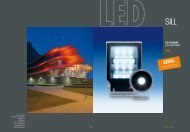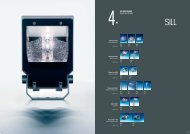- Page 1:
LED Luminaire programme 2012/2013Ma
- Page 5 and 6:
LED Quick SearchWork zones - Light
- Page 7 and 8:
Focus LEDInnovation with experience
- Page 9 and 10:
WILA - StandardsPerformance, Effici
- Page 11 and 12:
LED Project Solutions10 WILA
- Page 13 and 14:
LED Facade Illumination12 WILA
- Page 15 and 16:
Integrated Building TechnologyStair
- Page 17 and 18:
LED Handrail System16 WILA
- Page 19 and 20:
LED Handrail SystemLED Puck18 WILA
- Page 21 and 22:
LED Wall and Surface mounted Lumina
- Page 23 and 24:
LED Wall mounted Luminaires22 WILA
- Page 25 and 26:
LED Wall mounted Luminaires24 WILA
- Page 27 and 28:
LED Pendant Luminaires in compact D
- Page 29 and 30:
LED Pendant Luminaires - Multifunct
- Page 31:
Individual LED ProfilesConsultantLa
- Page 34 and 35:
LED office luminaire system with se
- Page 36 and 37:
ArchitectFletcher Priest, London,Gr
- Page 38 and 39:
Integrative Installation systemThe
- Page 40 and 41:
The absolute ceiling integrationWIL
- Page 42 and 43:
LED Nero Power surfacemountedCeilin
- Page 44 and 45:
LED Panel - Homogeneousoptics for l
- Page 46 and 47:
LED illumination in compactdesignTh
- Page 48 and 49:
LED Downlights Tunable WhiteSetting
- Page 50 and 51:
Integrated safety for emergencyligh
- Page 52 and 53:
Vertical Surfaces1/3 xWall washers
- Page 54 and 55:
Cardiac Catheter Laboratorywith LED
- Page 56 and 57:
www.wila.com 55
- Page 58 and 59:
Clean optics for connectingpassages
- Page 60 and 61:
A plus for safety -London Undergrou
- Page 62 and 63:
Ball-strike protected lightSometime
- Page 64 and 65:
LED Downlight with light ringThese
- Page 66 and 67:
www.wila.com 65
- Page 68 and 69:
E Connect ® Exilum - Decorative il
- Page 70 and 71:
DownlightsWallwasher DownlightsDown
- Page 72 and 73:
LEDE Connect ® Nero Power Recessed
- Page 74 and 75:
LEDE Connect ® Nero Power Recessed
- Page 76 and 77:
LEDE Connect ® Nero Power Recessed
- Page 78 and 79:
LEDE Connect ® Nero Power Recessed
- Page 80 and 81:
Colour Rendering Index CRIWhere spe
- Page 82 and 83:
EL26 LED DownlightsNero Accent LED
- Page 84 and 85:
EL26 LED DownlightsNero Accent LED
- Page 86 and 87:
www.wila.com 85
- Page 88 and 89:
EL29 LED Directional SpotlightsNero
- Page 90 and 91:
Soft Disc IP 44, mirror reflector m
- Page 92 and 93:
www.wila.com 91
- Page 94 and 95:
LED RecessedLuminaires for floor an
- Page 96 and 97:
Floor mountedsatin stainless steel
- Page 98 and 99:
www.wila.com 97
- Page 100 and 101:
LEDE Connect ® Exilum Recessed Lum
- Page 102 and 103:
www.wila.com 101
- Page 104 and 105: www.wila.com 103
- Page 106 and 107: DownlightsDownlights with Liteoptic
- Page 108 and 109: LEDTentec ® Recessed LuminairesDow
- Page 110 and 111: www.wila.com 109
- Page 112 and 113: LEDTentec ® Recessed LuminairesDow
- Page 114 and 115: www.wila.com 113
- Page 116 and 117: One for all, all for oneWith only t
- Page 118 and 119: R08 for LED retrofit lamps withdiam
- Page 120 and 121: www.wila.com 119
- Page 122 and 123: www.wila.com 121
- Page 124 and 125: E Connect ® Nero AccentSoft disc,
- Page 126 and 127: Concrete mounting boxesfor Nero Pow
- Page 128 and 129: System and supporting ring for rece
- Page 130 and 131: Mounting plate for the reinforcemen
- Page 132 and 133: Lamp/Wattage Dimension Article numb
- Page 134 and 135: www.wila.com 133
- Page 136 and 137: Scope of applicationThe European st
- Page 138 and 139: Direct glareDirect glare is generat
- Page 140 and 141: Cylindrical illuminanceGood visual
- Page 142 and 143: Illuminance according to EN 12464-1
- Page 144 and 145: Flood - Efficient illumination ofla
- Page 146 and 147: Narrow beamThe "curtain of light" t
- Page 148 and 149: Upside-downReversing familiar visua
- Page 150 and 151: Ceiling accentsEven with recessed c
- Page 152 and 153: Planning grid roomThe chart is inte
- Page 156 and 157: Colour Rendering Index CRIThe colou
- Page 158 and 159: Luminaire luminous flux LlmThe lumi
- Page 160 and 161: Maintenance InstructionsThe illumin
- Page 162 and 163: www.wila.com 161
- Page 164 and 165: Article number Page Article number
- Page 166 and 167: Article number Page Article number
- Page 168 and 169: Article number Page Article number
- Page 170 and 171: Article number Page Article number
- Page 172 and 173: 3.3 The Supplier shall not be liabl
- Page 174 and 175: WILA products are available worldwi






